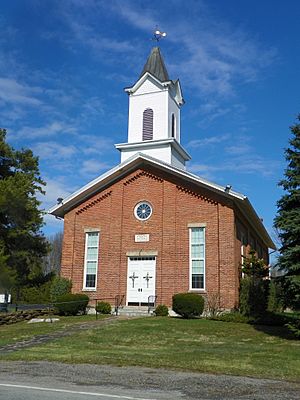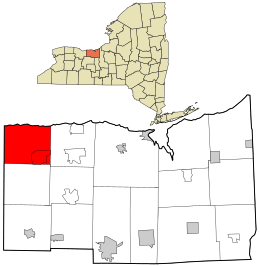Ontario, New York facts for kids
Quick facts for kids
Ontario, New York
|
|
|---|---|

North Ontario United Methodist Church
|
|
| Motto(s):
A Community of Good Neighbors
|
|

Location in Wayne County and the state of New York.
|
|
| Country | United States |
| State | New York |
| County | Wayne |
| Settled | 1806 |
| Established | March 27, 1807 |
| Government | |
| • Type | Town Board |
| Area | |
| • Total | 32.50 sq mi (84.17 km2) |
| • Land | 32.41 sq mi (83.95 km2) |
| • Water | 0.09 sq mi (0.22 km2) |
| Elevation | 377 ft (115 m) |
| Population
(2010)
|
|
| • Total | 10,136 |
| • Estimate
(2016)
|
10,064 |
| • Density | 310.50/sq mi (119.89/km2) |
| Time zone | UTC-5 (Eastern (EST)) |
| • Summer (DST) | UTC-4 (EDT) |
| ZIP code |
14519
|
| Area code(s) | 315, 585 and 680 |
| FIPS code | 36-55013 |
| GNIS feature ID | 0979313 |
| Website | http://www.ontariotown.org/ |
Ontario is a small town located in the northwest part of Wayne County, New York. It's named after the big Great Lake that forms its northern border, Lake Ontario.
In 2010, about 10,136 people lived here. The town also has a smaller area called a hamlet, which is also named Ontario. This is where the main government offices for the town are located.
Contents
Discovering Ontario's Past
The first person to settle in Ontario was Freeman Hopkins in 1806. He built a simple log cabin for his large family, which included his wife and nine children. Life was tough for these early settlers because of the thick forests and swampy areas.
How Ontario Was Formed
The town of Ontario was officially created on March 27, 1807. It was first called "Town of Freetown" and was part of another town called Williamson. Soon after, its name was changed to "Ontario." Later, in 1829, a part of Ontario was used to create the town of Walworth.
Iron and Trains: Early Industries
In 1811, people discovered iron ore in the area. This led to a busy business of melting iron, which continued for many years, even past the end of the 1800s.
Later, in 1874, a railroad called the Lake Ontario Shore Railroad opened. This made it easier for people and goods to travel. Today, this railroad is known as the R., W. & O.
Modern Power: The Ginna Nuclear Plant
On June 1, 1970, the Robert E. Ginna Nuclear Power Plant began operating. It's located right on the shore of Lake Ontario within the town, close to the Monroe County line. This plant helps produce electricity for the area.
Ontario's Location and Landscape
Ontario covers about 32.3 square miles (84.17 square kilometers). Most of this area is land, with a small part being water.
Where is Ontario?
The northern edge of Ontario touches Lake Ontario. The western side of the town borders Monroe County. This means Ontario is located just east of the City of Rochester.
Main Roads in Ontario
Two important highways cross through Ontario:
- New York State Route 104: This highway runs from east to west.
- New York State Route 350: This highway runs from north to south.
These two roads meet at a place called Ontario Center.
People Living in Ontario
| Historical population | |||
|---|---|---|---|
| Census | Pop. | %± | |
| 1820 | 2,233 | — | |
| 1830 | 1,587 | −28.9% | |
| 1840 | 1,889 | 19.0% | |
| 1850 | 2,246 | 18.9% | |
| 1860 | 2,320 | 3.3% | |
| 1870 | 2,295 | −1.1% | |
| 1880 | 2,962 | 29.1% | |
| 1890 | 2,611 | −11.9% | |
| 1900 | 2,550 | −2.3% | |
| 1910 | 2,672 | 4.8% | |
| 1920 | 2,620 | −1.9% | |
| 1930 | 2,713 | 3.5% | |
| 1940 | 2,851 | 5.1% | |
| 1950 | 3,297 | 15.6% | |
| 1960 | 4,259 | 29.2% | |
| 1970 | 6,014 | 41.2% | |
| 1980 | 7,480 | 24.4% | |
| 1990 | 8,560 | 14.4% | |
| 2000 | 9,778 | 14.2% | |
| 2010 | 10,136 | 3.7% | |
| 2016 (est.) | 10,064 | −0.7% | |
| U.S. Decennial Census | |||
According to the 2010 census, there were 10,136 people living in Ontario. The town has a mix of different backgrounds. Most residents are White, with smaller percentages of Black, Native American, and Asian people. About 1.6% of the population identified as Hispanic or Latino.
Families and Homes
There were about 3,960 households in Ontario in 2010. Many of these were married couples living together. About 32.2% of households had children under 18 living with them. The average household had about 2.56 people.
The median age of people in Ontario was 42.1 years old. This means half the population was older than 42.1, and half was younger.
Places and Communities in Ontario
The Town of Ontario includes several smaller communities and interesting spots:
- Bear Creek — This small community is by the lake on County Road 101. It used to be a port where iron ore from the county was loaded onto ships.
- Fruitland — You can find Fruitland west of Ontario Center on NY-104.
- Furnaceville — This community is near the eastern town line on County Road 110. It was home to one of the last big iron furnaces, which operated from 1825 to 1887.
- Ginna Nuclear Generating Station — As mentioned before, this is a nuclear power plant located on the shore of Lake Ontario.
- Lakeside — Despite its name, this community on Route 104 (north of Fruitland on County Road 102) is not directly on the lake.
- Ontario — This is the main hamlet of the town, located on NY-104 and County Road 110 in the southeastern part. It was first settled around 1807. The Brick Church Corners historic district is a special area here that was added to the National Register of Historic Places in 1973.
- Ontario Center — This community is located where NY-104 and NY-350 meet. The First Presbyterian Church of Ontario Center is a historic building here, listed on the National Register of Historic Places in 1998.
- Ontario-on-the-Lake — This community is right on the lake in the northwest corner of the town, on County Road 101.
- Union Hill — This community is near the western town line on NY-104. Part of it also extends into Monroe County.
Neighboring Towns
Ontario shares its borders with these towns:
See also
 In Spanish: Ontario (Nueva York) para niños
In Spanish: Ontario (Nueva York) para niños


